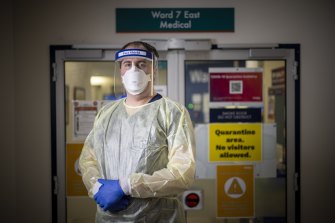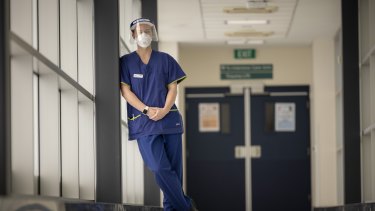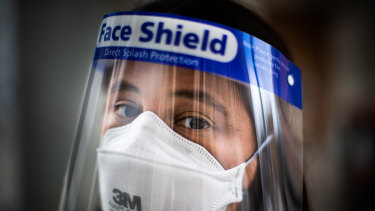Victorian healthcare workers brace for record numbers of coronavirus patients
The patients filling the COVID-19 ward at Melbourne’s Austin Hospital last year were elderly, delirious and frail. This year, they look more like the young cardiologists caring for them.
Nobody wants to be working on a coronavirus ward. But 37-year-old doctor Nick Jones and countless other healthcare workers say they will continue turning up to care for patients critically ill with the disease for as long as they are needed.

Cardiologist Nick Jones.Credit:Wayne Taylor
“Everybody is exhausted,†the cardiologist and general physician says as he adjusts a face shield digging into this skin.
“It can be very confronting. We now have patients being admitted from 16-year-olds old all the way up into their 60s.â€
“We are doing this job because we want to help people and this is where the help is needed right now.â€
An alarm blares and red lights flash in the corridor outside the intensive care unit at the Austin, in Melbourne’s north-east, as a crackling voice over a loudspeaker warns hospital staff another suspected coronavirus patient is being transported from the emergency department to the COVID-19 ward.
It is just before midday on Wednesday and the doors to the general intensive care unit, full of seriously ill, non-coronavirus patients, are vacuum-sealed shut, to prevent the virus from seeping in, as the patient is rushed through the corridor.
Across the hall, another glass door is fastened shut, a bright yellow sign on the window: COVID-19 room, do not enter. Behind the door sit a row of isolated rooms, housing the most gravely ill coronavirus patients in the hospital.
It is here that intensive care nurse Tayla Christofakakis spends her day. “The COVID ICU pod is filling up so quickly compared to last year,†Ms Christofakakis says. “We had one patient on Saturday. It’s now Wednesday and we have had eight admitted that are really, really sick.â€
Upstairs, another 18 seriously ill Victorians have been admitted to the two coronavirus wards.

Intensive care nurse Tayla Christofakakis.Credit:Wayne Taylor
In a sunlit hospital room, a dark haired, bare-chested man sits up in bed as a nurse, wearing a pale blue isolation gown, face mask, plastic goggles and gloves, gently checks his vitals.
The corridor outside the man’s room is busy. Doctors and nurses working in the coronavirus ward flow in and out of isolated rooms, designed to separate patients at their most infectious period.
Under bright fluorescent lights, a colourful aquarium beams down from a large television screen hanging above the nurses’ station desk.
Dr Jones says the television screen saver is sometimes changed to a live zoo, depending on the mood of the staff on the day.
Each morning a group of healthcare workers dressed head to toe in hospital gowns, face shields and masks, gather at the COVID ward nurses’ station to do morning exercises before they begin their shifts; a way to psyche themselves up for another gruelling day in a global pandemic inching towards two years.
There is a young mother infected with a virus in the ward who recently gave birth, separated from her newborn baby, who remains at a different hospital. Fit tradesmen and teenagers. Entire families have been splintered.
“There are young patients who have big extended families with young kids and they’ve all got COVID,†Dr Jones says.
“They’re all struggling at home or spread out through different hospitals so it can be really, really tough for them. There’s an emotional component that didn’t really exist last year.â€
The mood at the Austin Hospital is one of trepidation. Staff are bracing for a volume of COVID-19 patients never experienced in Australia.
“There’s some anxiety about that, but also there’s this realisation that we just can’t keep ourselves locked away forever,†Dr Jones says.
“We look overseas at Israel, the UK; they have opened up and had spikes in cases and spikes and in ICU admissions. We know our work lives are about to get extremely busy.â€
Last year it felt like a sprint, Dr Jones says. Now, it is a marathon. “We are preparing for the long haul.â€
Those admitted into the ICU have hypoxemia as coronavirus starves their lungs of oxygen. Others have multi-organ failure. Ms Christofakakis spends her shift carefully monitoring the vitals of unconscious patients hooked up to ventilators.
“It is very challenging at the moment because we’re so concerned about the influx of patients that are going to be coming,†the 29-year-old says.
“COVID is increasing in the community even with vaccination rates improving. We’re still getting a high number of patients coming through ... a lot of them are needing intensive care. It feels like this is the new normal.â€
Ms Christofakakis spent shifts in 2020 holding the hands of people succumbing to the virus, their families watching them take their final breaths during FaceTime calls.
She often decorated the rooms of those infected with the virus with photos of their family; something she is preparing to do all over again in coming months.
“It’s really hard when somebody is dying and they can’t have their families there,†she says. “It’s the most devastating part of the job.â€
Last year, patients who ended up in ICU mostly caught the virus at home. But now, they are being infected at supermarkets, shops and in their workplaces. None of the patients in intensive care at the Austin have been fully vaccinated.
About 16 kilometres away, at the emergency and trauma centre at The Alfred, it’s clear the winds of the pandemic are shifting. During Melbourne’s lockdown last year there was a slight drop in presentations, but as the third wave settles in, the increasing numbers of coronavirus patients are adding to the usual workload.
Early this week there were around 20 people with suspected COVID in isolation rooms in The Alfred’s emergency department at any one time. There is a firm expectation this number will increase in the coming weeks and months
Emma Hall, an associate nurse manager at the city unit, says she and other health workers were looking towards what was happening in New South Wales for what might be coming, and how to best prepare for it. The number of hospitalisations in NSW, at 1245 on Friday, is about six times higher than in Victoria.
â€It can become upsetting to know that maybe there might be a time where you may not be able to give everyone what they need, because of the number of people you’re going to have to be looking after,†she says.

Assistant nurse manager Emma Hall at The Alfred.Credit:Eddie Jim
“And it’s not anyone’s fault. It’s just the nature of the pandemic. I guess we are just all trying our very best, with what we’ve got.â€
The 29-year-old expects to carry parts of this pandemic with her for the rest of her life.
Not all of it will be bad. There is the tight bond she has developed with her weary colleagues, now like family. And there have been times she and her team have been able to triumph despite the extraordinary working conditions.
She recalls a time when an elderly woman was admitted to the emergency department about to die, but as she was showing COVID symptoms had to be placed into isolation and separated from her family.
Staff rushed to swab her and get her negative test back in record time, so that she could be reunited with her loved ones for her final moments, and not die alone.
“We were able to get her family in to hold her hand as she passed,†Ms Hall says.
Asked if she had a message for the public, the nurse of more than six years asked Victorians: “Just not to forget about us.â€
“It’s easy to listen to what’s being said on the news and blame other people for things that are going wrong, but at the end of the day every single nurse, doctor and healthcare worker in Victoria and Australia is going to work and trying to do the best they possibly can.â€
The emotional and mental toll of healthcare workers has been profound. A recent survey of more than 7800 Australian health care workers, most of whom were based in Victoria, found more than 40 per cent had symptoms of post-traumatic stress disorder by the final stages of the state’s second wave (although few recognised them as such).
This meant they may have been easily startled, had trouble sleeping, had continually recurring thoughts or felt irritable, according to one of the lead authors of the Monash University and Royal Melbourne Hospital study, respiratory physician Natasha Smallwood.
Of concern, one of the significant predictors of PTSD, along with emotional exhaustion and burnout, was if health care workers worried their patients would not receive the appropriate level of care because of a shortage of resources â€" an issue that continues to be the heart of the debate around Australia’s response to the pandemic
Associate Professor Smallwood said the ability of the hospital system to cope with increasing cases of COVID remained a worry, and also that other patients might suffer because their treatments were delayed as a result.
She had seen public comments expressing frustration that this continued to be an issue given hospitals “had 18 months to prepare†but says people need to understand that extra staff can’t be magicked up overnight.
“It’s not as simple as saying ‘We’ll train more’ because that training is for a doctor six years and for a nurse or allied health person three or four years.â€
The months between coronavirus outbreaks in Victoria have been spent trying to catch up on delayed care, as demand on the health system hit record highs.
“If you look at overseas, the UK has realised it needs £10 billion to deal with the effects of the virus, plus the catch at work,†Professor Smallwood said. “Nobody has stopped, nobody has had time off. So when those comments are made … people have to understand it’s been 18-months of really hard work.“
Monash Children’s Hospital director Professor Nick Freezer has witnessed first hand the toll the pandemic has taken on healthcare workers.
“The numbers go up, the numbers go down,†he says. “But the preparation that hospitals have to do in the background is relentless.â€
Children were largely spared when Melbourne’s hospitals filled up with coronavirus-stricken adults last year. But at Monash Children’s Hospital, staff say a rising number of feverish children are arriving at the hospital with chest pain, vomiting and diarrhoea.

Healthcare workers inside one of the coronavirus wards at the Austin Hospital this week.Credit:Wayne Taylor
Of the 4974 active cases, roughly 30 per cent are in people under the age of 19.
“There is a real anxiety about the rising numbers that we’re seeing in this wave of children,†Professor Freezer says.
A pandemic ward has been set up for children infected with coronavirus at Monash Children’s Hospital, with plans to increase capacity if the need arises. Three of the 16 beds were taken by children infected with the virus this week.
Another seven children were admitted to the Royal Children’s Hospital, including a baby that remained in intensive care on Friday. The vast majority of children infected require low-level care at home with their families.
Professor Freezer is quick to point out that children remain at much lower risk of getting seriously sick with the coronavirus, especially compared with unvaccinated adults. There is no robust evidence to suggest Delta makes children sicker.
Children needing hospital care are kept in isolation wards for two weeks with a ventilation system set up to stop cross-infection. One masked-up parent is allowed to stay by the child’s bedside at all times. To date, no children in Australia have died from coronavirus.
Meanwhile, at the Royal Melbourne Hospital, coronavirus wards are filling swiftly.
By Friday, there were 60 people in the hospital’s coronavirus wards, including 15 in intensive care. Some were so sick upon arriving at the emergency department, they were immediately admitted to ICU.
“We know we are in for a tough few months at least and we are really seeing the numbers rise,†specialist intensive care doctor Yasmine Ali Abdelhamid, says. “But there is a real sense that we are prepared for whatever comes.â€

Specialist intensivist Yasmine Ali Abdelhamid.Credit:Jason South
As Victoria’s coronavirus outbreak grows and pressure on staff at the Royal Melbourne Hospital intensifies, letters from children have been sent in from nearby schools thanking healthcare workers for caring for the ill.
Handwritten cards from the children adorn the walls of the ICU. Hot dinners arrive at the hospital doorstep from staff working at a pub nearby, shuttered due to the lockdown.
Dr Ali Abdelhamid says she has been heartened by Victoria’s rising vaccination rates; a reminder that it is not a battle fought in the hospital alone.
“We will help anyone who is sick who comes into hospital,†she says. “But this is really a fight that is fought at the community level. Everybody has a part to play.
“Every time someone wears a mask, every time someone gets vaccinated or stays home instead of going out they are actually probably helping in a much larger way than I can as an individual doctor at the hospital.â€

0 Response to "Victorian healthcare workers brace for record numbers of coronavirus patients"
Post a Comment